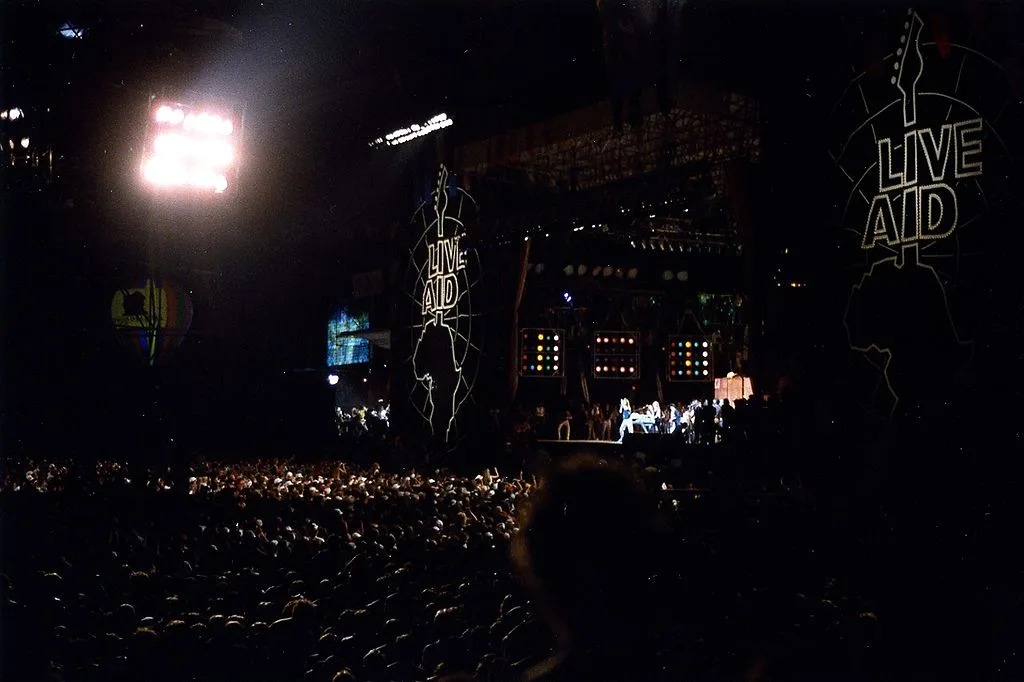In the annals of music history, few events stand as tall and resounding as the Live Aid 1985 music festival. A historic gathering of some of the biggest names in the music industry, Live Aid wasn’t merely a concert; it was a global call to action, a crescendo of compassion aimed at alleviating the devastating famine in Ethiopia during the mid-1980s.

The Concert
Live Aid took place on July 13, 1985, at two iconic venues: Wembley Stadium in London and John F. Kennedy Stadium in Philadelphia. The brainchild of Bob Geldof, lead singer of the Boomtown Rats, and Midge Ure, lead singer of Ultravox, the festival boasted a star-studded lineup that included Queen, U2, David Bowie, Led Zeppelin, and many others.
The event was a marathon of music, with performances spanning more than 16 hours. The global audience, estimated at 1.9 billion people across 150 nations, watched in awe as their favorite artists came together for a common cause. The sheer scale of the concert, combined with the charismatic performances, made it an unforgettable experience for both the attendees and those watching from the comfort of their homes.
Memorable Moments
Several moments from Live Aid 1985 have etched themselves into the collective memory of music enthusiasts. Queen’s electrifying performance, culminating in Freddie Mercury’s legendary call-and-response with the audience during “Radio Ga Ga,” is often hailed as one of the greatest live performances in rock history. U2’s Bono dancing with a fan pulled from the crowd and David Bowie’s duet with Mick Jagger are also standout memories from the concert.
Beyond the glitz and glamour, Live Aid showcased the power of collaboration. Artists set aside egos and genres to unite for a common cause, emphasizing the universal language of music as a force for positive change.
Impact on the Music Industry and Popular Culture
Live Aid had a profound impact on the music industry and popular culture. It not only raised over £125 million ($125 million USD) for famine relief but also served as a catalyst for subsequent benefit concerts and charity initiatives. The success of Live Aid demonstrated that music could be a powerful tool for social change, influencing future generations of musicians and philanthropists.

The concert also marked a turning point in how the music industry perceived its social responsibility. Artists realized the potential for their platform to address global issues, inspiring a wave of activism that continues to resonate in the industry today. Live Aid set a precedent for musicians to use their influence for charitable causes, a tradition that persists with events like the Global Citizen Festival and Band Aid 30.
The Cause
The genesis of Live Aid lay in the desperate situation in Ethiopia. In the mid-1980s, the country was grappling with a severe famine exacerbated by political instability and drought. Images of emaciated children and families struggling to survive shocked the world, prompting a collective call to action.

The funds raised by Live Aid were channeled through the Band Aid Trust, established by Geldof and Ure. The money primarily went towards famine relief efforts, providing food, medical aid, and long-term development assistance in Ethiopia. Organizations like UNICEF and Oxfam were instrumental in distributing aid to those in need.
Long-Term Impact on Famine Relief
Beyond its immediate impact, Live Aid had a lasting effect on the cause of famine relief. The funds raised contributed significantly to alleviating the crisis in Ethiopia, saving countless lives. The concert also brought global attention to the interconnected issues of poverty, hunger, and political instability, fostering a sense of international solidarity.
However, Live Aid also faced criticisms regarding the distribution of aid and its long-term efficacy. Some argued that the relief efforts were hindered by logistical challenges and political complexities. Nevertheless, the concert undeniably played a pivotal role in raising awareness about the plight of the Ethiopian people and mobilizing resources for immediate relief.
Conclusion
The Live Aid 1985 music festival stands as a testament to the transformative power of music and collective human compassion. Its impact reverberates through the decades, reminding us of the extraordinary things that can be achieved when artists and audiences come together for a greater purpose.
In the context of pop culture history, Live Aid occupies a sacred space. It wasn’t just a concert; it was a defining moment that bridged the gap between entertainment and activism. The festival demonstrated that music could transcend its role as mere entertainment, becoming a force capable of inspiring positive change on a global scale.
As we reflect on Live Aid, let us remember not only the iconic performances but also the indomitable spirit of unity and empathy that defined the event. In a world often divided, Live Aid remains a symbol of what can be achieved when humanity unites for a common cause, using the universal language of music to create lasting ripples of change.
- Live Aid 1985: The Music Festival That Changed History - January 11, 2024






